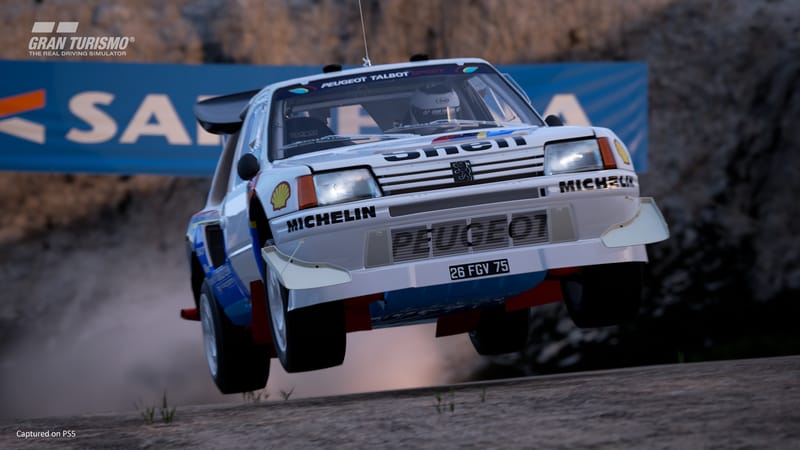Motorsports Racing News & Blog Articles
Review: Gran Turismo 7 – PS5
Gran Turismo has been a part of the gaming and automotive consciousness for 25 years. From the first title that was released on the original Playstation, through quirky releases such as Tokyo Geneva, all the way to GT Sport; Gran Turismo has been one of the defining racing games of the 21st century. 4 years on from GT Sport, Polyphony Digital have released their first full fat numbered outing on Playstation 5 to a lot of hype. Can GT7 execute a perfect race or will it mess up a crucial pit-stop that costs them win?
First lets talk about the graphics of the game. When you first load the game, you can choose whether to use ‘Performance’ mode or ‘Ray Tracing’ mode. The performance mode gives you a buttery smooth 60fps to experience the game through whilst ray tracing will mean you see drops in intense situations like rain or some pack racing but the imagery is beautiful. The performance mode is no slouch though, driving through the hills of Trial Mountain while the sun is setting looks absolutely gorgeous to the point I forgot to brake at the end of the back straight because I was admiring the view.
The cars are very well modeled but the approach by the team has been slightly different. Instead of increasing the amount of polygons that are used to make each car by a momentous amount over GT Sport, they increased the resolution and details that are on the car. Zoom in on a car’s rear tail lamps and you can see the imperfections in the glass as well as small fixings that hold it together. The best compromise I found to get the best version of this game looks wise, was to use performance mode as a default then switch to ray tracing if I wanted to view replays or utilise the fantastic Scapes mode.
 Credit: Polyphony Digital
Credit: Polyphony DigitalOnto how the game actually handles. I have been playing this game for 20+ hours with a pad as my primary input, and I have to say that the Dual Sense controller has left me staggered. The haptic feedback system that the controller has, allows the user to feel each imperfection in the road to a level of detail I have never experienced with a controller. The braking trigger is stiffened to give the sense of hydraulic braking although I did end up turning this off due to long play times meaning I got cramp in my left hand. If you are not able to experience this game with a wheel like me, then this makes that feeling of missing out a lot less.
The actual physics of the cars though is a contentious point. For me some cars such as the Ford Mustang GT350 can break traction suddenly without giving the player a chance to catch the slide. I have mainly found this in the higher powered rear drive road cars where as the machines running 4 wheel drive are a lot easier and more composed around a corner. Experiencing front wheel drive is exactly like you’d expect, the car understeers and you can feel the tyres scrubbing across the surface of the track.
You can visit the Tuning shop and GT Auto to iron out some of these kinks in various ways but the main gripe of the traction breaking suddenly still remains, at least on pad. The race cars do feel more planted and you do get a lot more confidence in knowing when to accelerate however be warned, upgrading these cars can make you lose that feeling unless you make sure to tune everything. I initially slotted a medium rev turbo into the Toyota Castrol Supra and lets just say the typical GT500 grip wasn’t there.
One other thing of note is to do with the rallying areas. When taking a jump like you would in say WRC 10 or Dirt Rally 2.0, the car lands like it has bricks for suspension. You will land the jump then 80% of the time just shoot off to the right or left depending on what it feels like at that particular attempt. Softening the suspension doesn’t due that much to alleviate the problem so you are left with braking just before even the smallest of jumps. The AI can also be affected by this as well but in License Tests and other modes it can be the difference between a Gold time or a fail.
 Credit: Polyphony Digital
Credit: Polyphony DigitalYou’ll get to experience all this in the single-player to start with. When starting the game you will be taken to a new mode for Gran Turismo and that is the Music Rally. Music Rally essentially boils down to a checkpoint race like OutRun. A song is played while you are driving a given circuit and car. Instead of a traditional timer, its a beat timer that counts down; your job is to keep passing through the checkpoints which then add more ‘beats’, you then ultimately have to drive as far as you can while the song plays or until the beats runs out.
This is pure GT weirdness at its finest but it ultimately doesn’t add anything to the game. Music Rally is a separate mode to the actual single-player mode and as it is just a reskinned checkpoint race, there is really no incentive to go through the many permutations that are available.
Go through the first Music Rally and the long but awesome intro movie, and you get given a 3D World map. It’s here that you experience the first of many in-game characters that will be with you as you journey through the Cafe. Yes you read that right, the primary single-player campaign involves you going to the Cafe and being given a series of 39 menu books. The bulk of these will involve collecting 3 cars based on a particular theme and thus introduce you to the main goal to the whole game; collecting all the cars. You can speed some of this up by buying the cars it asksfor rather than going through the World Circuit events but considering gathering credits can be a real grind, I’d recommend doing it the latter way.
Other GT staples are here though with Licence Tests returning and Circuit Experience being there to offer more challenges and ways of gathering cars. I personally found the Licence Tests to be a little easy side with its gold target times, however there will be certain tests that a lot will get stuck on. Circuit Experience remains the same deal as the offering in GT Sport but there has been a new mode added which comes under the ‘Missions’ banner. These are a series of challenges with different themes but provide a challenge to the player if you are aiming for gold runs. Being able to drive the Chapparal 2J in this absolutely made me giddy but there is something for everyone with some longer pit-stop races and drifting challenges added too.
 Credit: Polyphony Digital
Credit: Polyphony DigitalThe game deserves praise for giving you a sense of progression. You start in the slower vehicles of the game but you work your way up to owning and driving the faster machines as you go. Tracks and modes are also unlocked through the Cafe meaning the reward loop keeps you coming back to the game. Too many racing games these days give you everything from the get go which can really dull the experience but the feeling you get of finally being able to drive a Porsche 911 RSR or other desirable car/track is what will keep you coming back to GT7
The game works on a Performance Point system similar to the PI index in the Forza series, but this can work against Gran Turismo. The AI aren’t the most difficult to race against, but even on hard mode, due to the upgrades and PP system, you can very quickly turn a difficult race into one where you are blowing the opposition away. This can mean that the campaign becomes a bit of a slog but overall, the thrill of pedaling these cars more than makes up for it.
This may not be the case for the Multiplayer though. Multiplayer is unlocked not too long after starting your Cafe journey but once you get into it, you can’t help but feel a little disappointed in the offering currently available. GT Sport’s BoP takes a back seat now and your car performance is based on how well you can tune and upgrade your car to the restrictions available. While this allows users to learn a new part of the game, it can leave the mode less accessible to those casual players who just want to hop on and know they’ll be competitive straight-away. The Sport mode returns as the iRacing lite offering which was mostly well received in GT Sport but at the time of writing, there hasn’t been any new offerings from the Daily Races and we have no idea how often they plan on updating the races.
 Credit: Polyphony Digital
Credit: Polyphony DigitalThere is also a traditional lobby mode but here they let it down with some bizarre quality of life choices, the main one being that to change the lobby settings you will have to restart it and get everyone to re join.
The Single-player and Multiplayer portions mean nothing though if there isn’t a sufficient car and track offering. GT7 comes with 400+ cars at launch to buy in various ways. From Ford GTs to the humble Suzuki Swift, you can buy the majority of the cars on offer from the Brand Central, however the fabled Used Car lot makes its return offering cheaper versions of Brand Central cars as well as older models that you won’t find there. Although the game is only a week old, I feel that 400+ cars isn’t enough for the Used Car dealer to give that feeling of finding an absolute gem that you would get in Gran Turismo 4 for example.
The final way of buying cars is leads into the most controversial aspect of the game and that’s the Hagerty Collection. This will offer cars that are of automotive historical significance such as the Mercedes CLK GTR LM. The lineup of cars rotates daily but these cars cost a significant chunk of money which can be where the grind of the game kicks in. Payouts for events can be rather small compared to the cars that the game tasks you with buying, which can lead to some to consider the micro transactions that are on offer. Unlike GT Sport, GT7 offer credits packages instead of the ability to buy the car.
The packages on offer are:
100,000 credits – $2.49 / £1.99250,000 credits – $4.99 / £3.99750,000 credits – $9.99 / £7.992,000,000 credits – $19.99 / £15.99This means that if you are unwilling to undertake the substantial grind, cars that cost 4 million in the collection can cost you £30. Now valuations can rise and dip but this is a disappointing inclusion to the game when in game rewards can be fairly low. Recently the game has received an update which has made the ability to gain these cars significantly harder. There were a selection of races that users were using to grind credits so that they can afford these cars, however this was patched to reduce the credits payouts for these events. Currently at the time of writing, a Porsche 917K is in the Hagerty Collection for 18,000,000CR. If you were to use micro-transactions for this car it will cost $189.99 or if you want to go through the grinding process post patch 1.08, you will have to complete the best paying race 663 times which is frankly ridiculous.
The developers have come out and said that this is to preserve the rarity of the cars and to mimic the real-life scarcity of being able to afford them. They also say that the reduced credit payouts are also to reflect driving time for that event. In practice, this is most definitely not the case. There is a mission that tasks you to race around Tsukuba in changeable conditions for 30 laps, the payout for this event that takes roughly half an hour is 10,000CR. On the other hand, the very next event which is a 1/4 mile drag race against a Honda Civic pays out 40,000CR. The practice that Sony and Polyphony Digital are showing is very disappointing and the fans have been very vocal since, and I hope they listen to them.
 Credit: Polyphony Digital
Credit: Polyphony DigitalEvery track that was in GT Sport has made the jump to GT7 along with a few new entries. Daytona Speedway joins the real world line-up, and the reborn classics of Trial Mountain, Deep Forest Raceway and High Speed Ring join the fictional. All of the returning classics have had some changes made to them to make them better for racing with the results actually very positive. Deep Forrest adds a hairpin on the back stretch which adds a much needed overtaking option, and Trial Mountain has been stretched and the final chicane made more of a 90 degree left right.
Despite these additions the game feels a little light on circuits. Although they have gone through each track and given them a new touch of paint and added 2 layouts, it doesn’t feel enough to keep the game from going stale eventually for the casual player.
One last thing of note, if you are planning on buying this on the Playstation 4, there are a few quality of life problems with the main issue being the load times. GT7 was very much designed to make use of the PS5 first and it does show at points.
Despite some strange quirks and questionable micro-transaction implementation, Gran Turismo 7 returns the numbered series to its roots and knocks it out the park. While some cars feel abit odd, on the whole they give you a great sense of driving and the sounds that they produce can leave you with goosebumps. The single-player offers a great sense of progression with its unlocks and keeps giving you reasons to keep coming back. The track offering isn’t greatly expanded upon but they are very well modelled, apart from one or two crowd members, and the returning classics give you that great sense of nostalgia! The multiplayer is where the game falls down but I am curious to see how balanced it is over the next few weeks and months. The micro-transaction area is the biggest minus for me and I hope that Polyphony either ups the player rewards in-game or decreases the price for the packs to make them not feel like a massive rip-off.
Would I recommend this game? On the whole, I’d say yes. This game has plenty to offer with the game providing enjoyment in a variety of ways, from driving to Scapes and the menu books, but the credit payouts and aggressive micro-transaction strategy being employed means I wouldn’t want anyone going into the game blindly without knowing the situation.
Copyright
© The Checkered Flag
